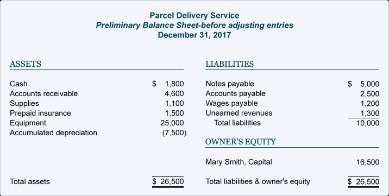
Investors might employ various hedging strategies such as stop-loss orders, which exit a position at a specific price level. Hedging can also involve using options strategies, which is akin to buying insurance whereby the strategies earn money as an investment position loses money from a negative event. As a result, businesses need to have contingency plans established to help minimize the lost revenue and increased costs that are involved when business operations have been disrupted. Typically, business consultants are hired to ensure contingency plans take a large number of possible scenarios into consideration and provide advice on how to best execute the plan. Although contingent liabilities are necessarily estimates, they only exist where it is probable that some amount of payment will be made. This is why they need to be reported via accounting procedures, and why they are regarded as “real” liabilities.
FRS 102: Provisions and contingencies under UK GAAP – economia
FRS 102: Provisions and contingencies under UK GAAP.
Posted: Fri, 07 Apr 2023 04:14:18 GMT [source]
A company involved in a legal case with the sheer expectation to receive the compensation which has a contingent asset as the outcome of the case is not yet known and the amount is yet to be determined. Of course, we won’t know if the banking sector’s contingency plan will be adequate until another recession occurs, which is a limitation of these plans since it’s difficult to plan for every contingency. If, for example, the company forecasts that 200 seats must be replaced under warranty for $50, the firm posts a debit (increase) to warranty expense for $10,000 and a credit (increase) to accrued warranty liability for $10,000. At the end of the year, the accounts are adjusted for the actual warranty expense incurred.
Educational material on applying IFRSs to climate-related matters updated
Accountants are in charge of generating financial statements and recording the transactions related to different assets and liabilities. There are two types of provisions, contingent liabilities, and contingent assets, which often require strict record-keeping. In accounting, contingent assets are recognised by the amount of cash generated from the event and removing it from accounts or providing the future cost of possible contingent liabilities on the balance sheet. Contingent liabilities adversely impact a company’s assets and net profitability. For U.S. GAAP, there generally needs to be a 70% likelihood that the gain occurs.
Contingent Assets as per IAS 37 are typically NOT recorded on a company’s balance sheet until the event that would trigger the realization of the asset occurs. This is because the value of a contingent asset is uncertain and may never be realized. A contingency is a potentially negative future event or circumstance, such as a global pandemic, natural disaster, or terrorist attack. By designing plans that take contingencies into account, companies, governments, and individuals are able to limit the damage done by such events. A contingency plan should also prepare for the loss of intellectual property through theft or destruction.
Use of provisions
Contingency plans are utilized by corporations, governments, investors, and by central banks, such as the Fed. Contingencies can involve real estate transactions, commodities, investments, currency exchange rates, and geopolitical risks. However, one should not extrapolate this agenda decision to a typical legal proceedings where, in case of an unfavourable court ruling, an entity is left without any asset. If the probability of inflow of resources is lower than 50%, entities do not provide any disclosure. That standard replaced parts of IAS 10 Contingencies and Events Occurring after the Balance Sheet Date that was issued in 1978 and that dealt with contingencies. Contingent asset accounting policies for GAAP, meanwhile, are mainly outlined in the Financial Accounting Standards Board’s (FASB) Accounting Standards Codification (ASC) Topic 450.
If the firm determines that the likelihood of the liability occurring is remote, the company does not need to disclose the potential liability. If the probability of inflow of resources is greater than 50%, contingent asset is disclosed (IAS 37.89) in the notes to financial statements (but not recognised in the statement of financial position). When it is virtually certain (say 90-95%, exact probability not specified in IAS 37) that the inflow of resources will take place, an asset is recognised in the statement of financial position. A business may disclose the existence of a contingent asset in the notes accompanying the financial statements when the inflow of economic benefits is probable. Doing so at least reveals the presence of a possible asset to the readers of the financial statements.
Join PRO or PRO Plus and Get Lifetime Access to Our Premium Materials
If there is a decent chance that Company ABC will win the case, it has a contingent asset. This potential asset will generally be disclosed in its financial statement, but not recorded as an asset until the lawsuit is settled. Company A Ltd. has filed a lawsuit against Company B Ltd. for infringing a patent case. If there is a good chance that Company A Ltd. will win the case, it has a contingent asset in this matter. This potential asset will generally be disclosed in the financial statement, but will not be recorded as an asset until the case is over and settled.
- An entity recognises a provision if it is probable that an outflow of cash or other economic resources will be required to settle the provision.
- However, one should not extrapolate this agenda decision to a typical legal proceedings where, in case of an unfavourable court ruling, an entity is left without any asset.
- Contingencies might also include contingent assets, which are benefits (rather than losses) that accrue to a company or individual given the resolution of some uncertain event in the future.
- With any type of disaster, cybercriminals often try to take advantage of a crisis to hack into a company’s systems and steal data or disrupt business operations.
- Hence, a that future intent liability is recorded in the balance sheet as a form of a footnote.
An entity recognises a provision if it is probable that an outflow of cash or other economic resources will be required to settle the provision. Unlike contingent assets, they refer to a potential loss that may be incurred, depending on how a certain future event unfolds. After understanding the meaning of contingent assets, we are going to learn examples of debit notes in business-to-business transactions about the IAS 37 Provisions Contingent Liabilities And Contingent Assets. IAS stands for International Accounting Standard and according to that, there is a specific outline of the treatment provided to contingent liabilities and contingent assets too. In a similar way Accounting Standard 29 was made by ICAI to deal with such treatment details.
IFRIC 1 — Changes in Existing Decommissioning, Restoration and Similar Liabilities
There is a possibility of ABC Ltd winning the case, as it has concrete evidence of contract violation by XYZ Ltd. Although risk management is an essential part of accounting, accountants are less likely to use contingencies because they can be more time-consuming and complex than simply including them within a forecast. Contingent assets are created when events happen concurrently, evaluated as assets or liabilities depending on their impact. With any type of disaster, cybercriminals often try to take advantage of a crisis to hack into a company’s systems and steal data or disrupt business operations.
- Asset diversification helps to minimize risk if one asset class, such as stocks, declines in value.
- Companies and investors plan for various contingencies through analysis and implementing protective measures.
- Now, the former can’t recognize this as a contingent asset even if it is sure to win and the amount can be estimated.
- Although there are various components that go into the tier-capital ratio requirement, the ratio has to be at least 6% of the total of risk-weighted assets.
Well, there might be certain conditions in accounting concepts that might lead to the absence of the contingent assets in the balance sheet. In case of uncertain events where the company is not in control of the events, there might be times when some of the contingent assets are not included. As an example of a contingent asset, a business believes that it will win a lawsuit against a competitor for a patent violation, and discloses the situation in its financial statement footnotes.
IAS 37 defines and also specifies the accounting for and disclosure of the provisions, of all the contingent liabilities, and all the contingent assets. Because of the concept of conservatism, a contingent asset and gain will not be recorded in a general ledger account or reported on the financial statements until they are certain. [This is different from contingent liabilities and contingent losses, which are recorded in accounts and reported on the financial statements when they are probable and the amount can be estimated. Also, according to the conservatism principle, some uncertain events of the future really must be recognized. However, any future incomes which are uncertain cannot be recognized in the present. This is what students get to know from the notes of provisions, contingent liabilities and contingent assets.

Alternatively, they might occur due to uncertainty relating to the outcome of an event in which an asset may be created. A contingent asset appears because of previous events, but the entirety of all asset information will not be collected until future events happen. A contingent asset is a potential economic benefit that is dependent on some future event(s) largely out of a company’s control. In accountancy, contingent assets (i.e., holdings without liability) are one of the company’s standard types of financial instruments. A contingency plan often allows a company affected by a negative event to keep operating. For example, a company may have a provision in place for possible industrial action, such as a strike, so obligations to customers are not compromised.
